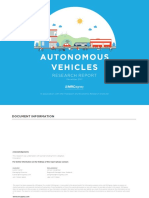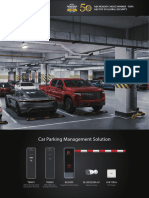Black Box Technology For Automobiles
Black Box Technology For Automobiles
Uploaded by
rgk_sCopyright:
Available Formats
Black Box Technology For Automobiles
Black Box Technology For Automobiles
Uploaded by
rgk_sOriginal Title
Copyright
Available Formats
Share this document
Did you find this document useful?
Is this content inappropriate?
Copyright:
Available Formats
Black Box Technology For Automobiles
Black Box Technology For Automobiles
Uploaded by
rgk_sCopyright:
Available Formats
BLACK BOX TECHNOLOGY FOR AUTOMOBILES
WHAT IS A BLACK BOX? Similar to a flight data recorder found on an aircraft, an automotive black box, also known as Event Data Recorder (EDR) is capable of recording certain information when activated by an event. An event is best described as a change in vehicle velocity that exceeds the manufacturer's predetermined threshold. Events are classified according to airbag status and are identified as either a deployment event or a near deployment event. Near Deployment events can be anything from moderate impacts (that do not deploy the airbag). Although some data may be obtained from other circuits, the majority of data is provided by the air bag system. As a result, the airbag control module in an automobile is actually used as the EDR or (black box). Different manufacturers use different names for the EDR. For instance, Ford calls it a Restraint Control Module (RCM). The Fords RCM only records crash data but not any pre-crash data.
General Motors (GM) calls their air bag control module a Sensing Diagnostic Module (SDM). GMs SDM provides basic crash data as well as 5 seconds of pre-crash information, such as speed, throttle position and brake position.
WHERE IS THE EDR? The EDR is usually located near the centre of the vehicle in order for it to be best protected and to measure the crash pulse near the vehicles centre of gravity. This means that it is usually below one of the front seats or under the centre console.
WHY HAVE AN EDR? Most vehicles are equipped with airbags which protects the occupant in a collision. Airbags only deploy in collisions of certain severity and direction. In order for the airbag system to know when and how to deploy the airbag, it must know what is going on and predict what is going to happen. The system accomplishes this by measuring specific data, such as vehicle speed and acceleration, collision direction, occupant seatbelt use, and other criteria. The various measurements are performed by sensors and the decision is made by the systems brain, which is the computer module. As the module already gathers information for the deployment decision, all that is needed is a recording device to make it a black box.
WHAT DATA CAN A BLACK BOX PROVIDE? The EDR is capable of recording and storing a variety of pertinent information but may differ from one manufacturer or model to another, some may include post-crash data only while others may also provide pre-crash data. Some EDRs record data from side impacts (those equipped with side air bags), force of impact and steering angle. The information could assist in establishing liability in the event of conflicting stories and settling disputes.
GMS RAW EDR DATA The data is downloaded to a computer and the computer data must be converted to something we can understand. An example of the raw data downloaded from a GM EDR is shown below. This proprietary code that can only be broken with a key. With the proper software the data is converted to practical output.
GMS PRE-CRASH DATA GM modules that do store pre-crash information typically record at one-second intervals from five (5) seconds prior to the event. It records vehicle speed, engine RPM, throttle percentage and brake switch status.
SYSTEM STATUS AT DEPLOYMENT The GM EDR also provides the system status at deployment which includes air bag warning lamp, driver seat belt, passenger air bag switch, how many times the vehicle has been started prior to and since the deployment, the time from the impact until the deployment (in milliseconds) and the time (if within 5 seconds) between a near deployment event and a deployment event.
GMS POST-CRASH DATA GM post-crash data measures forward velocity changes in mile per hour (MPH), at 10 millisecond (10/1000 of a second) increments for up to 300 milliseconds after the impact. This is the information that is crucial in establishing the severity of the impact in both magnitude and duration.
HOW IS THE DATA OBTAINED? General Motors was the first manufacturer to release their proprietary code to the public through a company called Vetronix that developed the Crash Data Retrieval (CDR) system.
The CDR module is connected to a laptop PC loaded with the Vetronix software and also connected via cable to the diagnostic link connector, also known as the OBDII port. If the OBDII port is damaged or inaccessible or if the vehicles electrical system is not operational, data can also be obtained directly from the EDR.
DATA RETRIEVAL METHODS
WHAT EDR DOES? EDRs can provide important information, such as collision severity (speed change), vehicle speed, throttle use, brake use, and seatbelt use. Some hypothetical situations where an EDR can assist in an investigation include: Sudden unintended acceleration a driver complains that the vehicle accelerated suddenly and would not slow down no matter how hard they applied the brakes. The EDR can confirm whether the brake or throttle was applied. An airbag malfunction deployed when it should not have or did not deploy when it should have. Witness Evidence - EDR data can be used to confirm or deny witness evidence (speed, seatbelt use).
WHAT EDR DOESNT? EDR use and capability is still in its infancy. They are an objective independent witness, but they have significant limitations and there are certain idiosyncrasies associated with them. For instance: The speed input is measured at the wheels or transmission. Therefore, a vehicle that is in yaw (sliding sideways) or braking fully may record an erroneous speed. Actual speed of the vehicle may be much higher or lower. Multiple impact crashes may not be recorded. Data may not be recorded or may be corrupted if power is lost during the collision. Low speed impacts do not produce accurate data. The impact severity is too low and the EDR data underestimates the severity.
THE POTENTIAL USES AND BENEFITS OF EDR DATA Insurance/Legal - Additional objective data provided by EDRs helps quick and fair resolution of insurance and liability issues. Law Enforcement - Obtaining EDR data from a collision would help in accurate determination of facts surrounding an incident. Government - Collection of EDR data facilitates government in furthering regulatory initiatives to help reduce fatalities, injuries and property loss. Vehicle Design - It allow manufacturers to collect better real world data to monitor system performance and improve vehicle design. Research - EDR data could provide objective databases on driver behaviour & performance, as well as other research related topics.
FEW VEHICLES WITH EDR INSTALLED Chevrolet Camaro, Ford Mustang, GMC Safari, Pontiac Firebird etc
THE NEXT STEP VDR (Video Data Recorder) It uses a built-in camera, GPS unit and G-force shock sensor (which is capable of tracing the point of impact during an accident on a three line X, Y, Z graph) to document accidents. When shock sensor detects an accident, the device takes video footage and is saved to a SD Card, making it accessible on a computer. It also records the time and location of an accident and documents your speed and direction of travel.
CONCLUSION The information could assist in establishing liability in the event of conflicting stories and settling disputes. Insurance companies will write into their policies who owns the EDR data and how the data will be handled. GM's SDM provides additional objective data to accident investigators for vehicles involved in crashes where a sufficient forward change in velocity is experienced, however, physical evidence from the vehicle and scene still needs to be analyzed.
You might also like
- ITP For Electrical WorksDocument22 pagesITP For Electrical WorksDebesh Chaudhary100% (7)
- E HailingDocument19 pagesE Hailingcuihuan996No ratings yet
- Utilization of Aerial Drone Technology in LogisticsDocument12 pagesUtilization of Aerial Drone Technology in LogisticsaxyyNo ratings yet
- Wialon Platform Overview CES2022Document32 pagesWialon Platform Overview CES2022Berita TerangNo ratings yet
- Code of Practice v8Document68 pagesCode of Practice v8Andy T UKNo ratings yet
- WITNESS Reference Manual 24-09-2009Document129 pagesWITNESS Reference Manual 24-09-2009Pablo SainzNo ratings yet
- Event Data RecorderDocument9 pagesEvent Data RecorderAleksandar KnezevicNo ratings yet
- EDR QAs 11aug2006Document11 pagesEDR QAs 11aug2006Caroline Speer NygaardNo ratings yet
- Manual de Usuario Honda Fit (2017) (465 Páginas)Document1 pageManual de Usuario Honda Fit (2017) (465 Páginas)Ars MagnaNo ratings yet
- OBD Data Collection: Methodology and Protocol in Accident CasesDocument10 pagesOBD Data Collection: Methodology and Protocol in Accident CasesRohit RajputNo ratings yet
- NHTSA-Toyota EDR Pre-Crash ValidationDocument32 pagesNHTSA-Toyota EDR Pre-Crash ValidationsinasayedanaNo ratings yet
- Hyundai Kia Crash Data EDR PDFDocument7 pagesHyundai Kia Crash Data EDR PDFBilal SultanNo ratings yet
- Tesla EDR SampleDocument18 pagesTesla EDR SampleRob TheDriveNo ratings yet
- MRCagney Autonomous Vehicles Research PaperDocument43 pagesMRCagney Autonomous Vehicles Research PaperBen RossNo ratings yet
- Black Box For Automobiles With Speed Control System For Collision AvoidanceDocument3 pagesBlack Box For Automobiles With Speed Control System For Collision AvoidanceerpublicationNo ratings yet
- EDR Report Oct-11 PDFDocument72 pagesEDR Report Oct-11 PDFShanon BurgessNo ratings yet
- DRIVERLESS CARS - Wikipedia PDFDocument156 pagesDRIVERLESS CARS - Wikipedia PDFlucky PatilNo ratings yet
- Unmanned Ground Vehicle For Simulating Unmanned Air Vehicle LandingDocument25 pagesUnmanned Ground Vehicle For Simulating Unmanned Air Vehicle LandingJonathan LuoNo ratings yet
- Us Fhwa - Safety Effects of Marked Vs Unmarked Crosswalks at Uncontrolled Locations - 04100Document114 pagesUs Fhwa - Safety Effects of Marked Vs Unmarked Crosswalks at Uncontrolled Locations - 04100prowagNo ratings yet
- Car Park Management Solution - 29aug2022Document11 pagesCar Park Management Solution - 29aug2022garydiazvelardeNo ratings yet
- Seminar ReportDocument34 pagesSeminar Reportabhay Maurya100% (1)
- Vehicle Detection SystemDocument4 pagesVehicle Detection SystemHrudhay LuckyNo ratings yet
- Presentation IoTDocument21 pagesPresentation IoTMuhammad HamzihNo ratings yet
- ITS Cookbook 2020 20200227 PDFDocument90 pagesITS Cookbook 2020 20200227 PDFMilton Cesar Ortiz Lopez MiceorNo ratings yet
- Evaluation of Advanced Air Bag Deployment Algorithm Performance 2008Document10 pagesEvaluation of Advanced Air Bag Deployment Algorithm Performance 2008wdwd1373No ratings yet
- Tesla Sample EDR Report YDocument30 pagesTesla Sample EDR Report YarstjunkNo ratings yet
- Getting It Right: Edestrian Ehicle OllisionsDocument63 pagesGetting It Right: Edestrian Ehicle OllisionsPetar OsijekNo ratings yet
- Automotive Systems - Day 1Document109 pagesAutomotive Systems - Day 1movebe6870No ratings yet
- Reducing Speeding-Related Crashes Involving Passenger VehiclesDocument97 pagesReducing Speeding-Related Crashes Involving Passenger Vehiclesmarjun lantangNo ratings yet
- Security and Control Risk Assessment of Toll Bridge OperationsDocument2 pagesSecurity and Control Risk Assessment of Toll Bridge OperationsMurukuri RavitejaNo ratings yet
- Individual Vehicle Approval Inspection Manual Vans PDFDocument277 pagesIndividual Vehicle Approval Inspection Manual Vans PDFAndrei SlaninaNo ratings yet
- Traffic Violation Detection System Based On RFIDDocument4 pagesTraffic Violation Detection System Based On RFIDMarvz IgnacioNo ratings yet
- OnStar Can Disable Your CarDocument3 pagesOnStar Can Disable Your CarjusdafaxNo ratings yet
- Surface Vehicle Recommended PracticeDocument41 pagesSurface Vehicle Recommended PracticeaamirNo ratings yet
- Automated Highway SystemsDocument41 pagesAutomated Highway SystemsSravaniChintalapaniNo ratings yet
- Handfree DrivingDocument17 pagesHandfree Drivingarnitha_akhila100% (1)
- Speed Detection of Moving Vehicle Using Speed CamerasDocument14 pagesSpeed Detection of Moving Vehicle Using Speed CamerasAnonymous ty7mAZ100% (1)
- On: Google Self Driving CarDocument21 pagesOn: Google Self Driving CarDevanshu sharmaNo ratings yet
- GPS and GPRS Based Real Time Vehicle Tracking On Google EarthDocument28 pagesGPS and GPRS Based Real Time Vehicle Tracking On Google EarthdkishoreNo ratings yet
- Automation of Cars in Embedded SystemsDocument10 pagesAutomation of Cars in Embedded SystemsVijetha YadlaNo ratings yet
- Addis Ababa University Addis Ababa Institute of Technology School of Electrical and Computer EngineeringDocument23 pagesAddis Ababa University Addis Ababa Institute of Technology School of Electrical and Computer Engineeringbegziew getnetNo ratings yet
- Leishen LiDAR Product Guide 7.20213Document27 pagesLeishen LiDAR Product Guide 7.20213Shailesh BishnoiNo ratings yet
- Transportation of Hazardous Goods - NotesDocument36 pagesTransportation of Hazardous Goods - NotesSachi AnandNo ratings yet
- Nassau County Red Light Camera 2014-2015 Report FinalDocument23 pagesNassau County Red Light Camera 2014-2015 Report FinalNewsdayNo ratings yet
- Individual Vehicle Approval Inspection Manual TrailersDocument142 pagesIndividual Vehicle Approval Inspection Manual Trailerss0mniNo ratings yet
- Research of Vehicle Tracking (VTracking App)Document7 pagesResearch of Vehicle Tracking (VTracking App)sailesh wankarNo ratings yet
- Automatic Number Plate Recognition 1Document20 pagesAutomatic Number Plate Recognition 1ABHISHEK CHAKRABORTYNo ratings yet
- Seminar Report by Rajesh ChoudharyDocument26 pagesSeminar Report by Rajesh Choudharyanirudh singh solankiNo ratings yet
- BMW OwnersManual 01405A392C9-1Document396 pagesBMW OwnersManual 01405A392C9-1Zeta QrsNo ratings yet
- Computerized Valet Parking System - Your Inside Guide On How They Work For Your BusinessDocument3 pagesComputerized Valet Parking System - Your Inside Guide On How They Work For Your BusinessAbdul GhaniNo ratings yet
- Crowdstrike Class ActionDocument28 pagesCrowdstrike Class Actionmichael.kanNo ratings yet
- Valet Parking System (0220-BSCA-17-E2) - Hafiz Ahmad TariqDocument25 pagesValet Parking System (0220-BSCA-17-E2) - Hafiz Ahmad TariqAbduallah MustafaNo ratings yet
- Enhanced Framework For Secure Smart Parking ManagementDocument8 pagesEnhanced Framework For Secure Smart Parking ManagementIJRASETPublicationsNo ratings yet
- Learners Book PDFDocument132 pagesLearners Book PDFgkaoae19No ratings yet
- MBTA Orange and Red Line Cars RFPDocument13 pagesMBTA Orange and Red Line Cars RFPNate BoroyanNo ratings yet
- Acc ppt-1Document17 pagesAcc ppt-1Mandeep Singh SanghotreaNo ratings yet
- Memorandum FOR: Isagani D. Galsim: Intelligence Group X-Ray Inspection Project Port of SubicDocument1 pageMemorandum FOR: Isagani D. Galsim: Intelligence Group X-Ray Inspection Project Port of SubicMarq BonifacioNo ratings yet
- Seminar Driverless CarDocument35 pagesSeminar Driverless CarChetan Sanikoppa Akkis75% (4)
- IJME - An Implementation - Jagadeesh VikramDocument8 pagesIJME - An Implementation - Jagadeesh Vikramiaset123100% (1)
- Honda Civic 2018 Quick ReferenceDocument86 pagesHonda Civic 2018 Quick ReferenceboodanukNo ratings yet
- Manual de Propietario Del Ford Edge 2012 (Inglés)Document396 pagesManual de Propietario Del Ford Edge 2012 (Inglés)Luis Alberto GarciaNo ratings yet
- Automatic Number Plate Recognition: Fundamentals and ApplicationsFrom EverandAutomatic Number Plate Recognition: Fundamentals and ApplicationsNo ratings yet
- Standard Check ListsDocument136 pagesStandard Check ListsRama Krishna Reddy Donthireddy100% (2)
- Manufacturing Technology - Metrology: Dr.B.Ramamoorthy Professor Manufacturing Engg. Section Iitmadras 600 036Document22 pagesManufacturing Technology - Metrology: Dr.B.Ramamoorthy Professor Manufacturing Engg. Section Iitmadras 600 036Ramasubramanian KannanNo ratings yet
- BSGS Sample Problems 1 - BB CollabDocument11 pagesBSGS Sample Problems 1 - BB CollabNeo GarceraNo ratings yet
- Powerroc T35 E: Surface Drill Rig For Construction, Road Construction and Urban DevelopmentDocument5 pagesPowerroc T35 E: Surface Drill Rig For Construction, Road Construction and Urban DevelopmentElgi Alam PangestuNo ratings yet
- HDL As Anfinal DestinationDocument21 pagesHDL As Anfinal DestinationRam VBITNo ratings yet
- Recrystallization Lab Report FinalDocument6 pagesRecrystallization Lab Report Finalapi-255889385No ratings yet
- Fiio F3Document1 pageFiio F3Fer CanoNo ratings yet
- Determination of Benzene and Toluene in Finished Motor and Aviation Gasoline by Gas ChromatographyDocument7 pagesDetermination of Benzene and Toluene in Finished Motor and Aviation Gasoline by Gas ChromatographyJako MishyNo ratings yet
- Hnad Over Procedure 1Document6 pagesHnad Over Procedure 1niventhanNo ratings yet
- 0.22949800 1265651349 Foto4 Miracare SLB 365g Tds Mar 07Document2 pages0.22949800 1265651349 Foto4 Miracare SLB 365g Tds Mar 07mjmorcelli100% (1)
- The Loose Source and Record Route (LSRR)Document15 pagesThe Loose Source and Record Route (LSRR)ruby26985No ratings yet
- Engine Control Jazz PDFDocument170 pagesEngine Control Jazz PDFKayun Agad100% (1)
- Exercise Questions - Introduction and Module # 1Document10 pagesExercise Questions - Introduction and Module # 1Justin Carrasco SanchezNo ratings yet
- Asme B 1.20.1 PDFDocument32 pagesAsme B 1.20.1 PDFjorge castanedaNo ratings yet
- PracticalsDocument158 pagesPracticalsBirajuNo ratings yet
- R-Me60056 Esmeril de Mano Dewalt DW882Document22 pagesR-Me60056 Esmeril de Mano Dewalt DW882Vero YotagriNo ratings yet
- Introduction To Engineering Drawing: Muhammad UsmanDocument7 pagesIntroduction To Engineering Drawing: Muhammad UsmanShakeel MohmandNo ratings yet
- Them I Cam Exhibitors CatalogueDocument195 pagesThem I Cam Exhibitors Cataloguecaila8716No ratings yet
- BO1 Eng - V3.0Document2 pagesBO1 Eng - V3.0hamenikjooNo ratings yet
- 2009-10-06 SmarTrax Longbox 4.2 Download and Installation InstructionsDocument3 pages2009-10-06 SmarTrax Longbox 4.2 Download and Installation InstructionsKrzysztof JakowieckiNo ratings yet
- Fuller RT 6610 Transmission Service ManualDocument88 pagesFuller RT 6610 Transmission Service Manualoldholden202No ratings yet
- Endpoint Encryption Powered by PGP Technology: Proof of Concept DocumentDocument9 pagesEndpoint Encryption Powered by PGP Technology: Proof of Concept DocumentNaveen AlluriNo ratings yet
- Simulation Model For The Calcination Process of Cement .: Idalia@unam - MXDocument8 pagesSimulation Model For The Calcination Process of Cement .: Idalia@unam - MXKARKAR NABILNo ratings yet
- Peshawer BRT AnalysisDocument11 pagesPeshawer BRT AnalysisAmina SaeedNo ratings yet
- Npcil TSDocument10 pagesNpcil TSBhavesh KeraliaNo ratings yet
- PDF Apha AwwaDocument60 pagesPDF Apha AwwaKen Ople100% (1)
- Laboratory Exercise 3: Atterberg Limits Test: ReferencesDocument10 pagesLaboratory Exercise 3: Atterberg Limits Test: ReferencesmoNo ratings yet
- 5 Tips To Write Successful Ambient Guitar Looping SongsDocument11 pages5 Tips To Write Successful Ambient Guitar Looping Songsitemcode23100% (1)

























































































